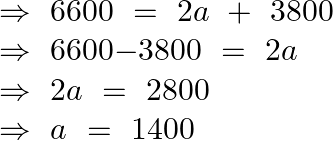Solution:
It is given that the total amount saved is 66000 in 20 years, therefore ![]()
Let ‘a’ be the amount saved in first year.
Then every year if he increases Rs. 200 every year then in second year the amount will be ‘a + 200’ and in third year it will be ‘a + 400’ and so on.
The sequence so formed will be a, a + 200, a + 400…
The sequence so formed is an AP and their common difference therefore is ![]()
As he saved money for 20 years therefore there are 20 terms in the sequence.
By using the formula for AP ![]() we obtain
we obtain
Where the number of terms is ‘n’ and the first term is ‘a’ and the common difference is ‘d’ Given that

As a result, Rs.1400 is the amount saved in first year.
